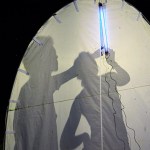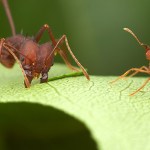entomology
Paratrechina Nylanderia phantasma
Archbold Biological Station, Florida
Here's an ant I almost didn't notice. Paratrechina Nylanderia phantasma is one of the least known insects in North America, active at night and restricted to a particular type of sandy soil in Florida. Workers are only a couple millimeters long and the color of sand. In the field they appear as ghostly little shapes skirting across the ground, scarcely visible even to those looking for them.
Incidentally, N. phantasma was named and described by James Trager, a frequent commentator here at Myrmecos…
In California, the pesty ant that invaded our kitchen was the Argentine ant (Linepithema humile). In Tucson, we had South American rover ants (Brachymyrmex patagonicus). Here in Illinois, our kitchen ant is a native species, Tapinoma sessile. At any given moment we probably have two or three wandering about our countertops.
The common name for this small brown insect is the Odorous House Ant, a reference to both the strong blue-cheesy odor these ants emit when crushed and to their habit of foraging indoors for food. They don't normally nest indoors, though, they prefer…
The summer insect season is upon us here in temperate North America, and with it comes the need for good identification guides.
Before I begin, a cautionary note. We have so many species on our continent that were we to create a bird-type guide that listed all the insects, with their ranges and identifying characteristics, the full set would span at least 30 volumes.  Any book small enough to carry into the field necessarily omits more than 95% of the relevant animals. Insect guides are understandably neurotic and overwhelmed compared to the corresponding bird and…
...well, not really. But an exchange I had at Photo Synthesis with Andrew Bleiman of Zooillogix got me thinking about all the different insects that have charmingly envenomated me at one time or another.
Myrmecia piliventris, Australia
So I'm starting a meme called Things That Have Stung Me. The rules are simple:
List all the things that have stung you.
Bites don't count.
Pass the meme to 3 or more other bloggers you suspect have also been well-zinged.
Here are mine.
Things that have stung me:
Ants:
Pachycondyla verenae
Pachycondyla harpax
Pachycondyla villosa…
Eastern Treehole Mosquito
My commercial gallery now has flies!
Diptera photographs at alexanderwild.com
I feel sort of embarassed at how few fly images I have, considering the importance of the group. That's something I'll try to remedy as we get into this summer's photography season.
It has long been known that ants recognize their deceased nestmates using the smell of fatty acids that accumulate as the body decomposes. The chemical signature of deadness helps ants remove the corpses from their midst, keeping a clean and sanitary nest. Indeed, this classic tale of ants and oleic acid is one of E. O. Wilson's favorite stories.
But it turns out that the story is even richer than previously supposed. A study by Dong-Hwan Choe et al published in yesterday's PNAS note that Argentine ants (Linepithema humile) carry away the dead even before the fatty acids appear…
Step 1. Locate a suitable patch of forest, field, or desert.
Step 2. Wait for a warm, moonless summer night.
Step 3. Using a long extension cord, plug in a blacklight. Or even better, a mercury-vapor lamp.
Step 4. Sit back and watch your prey arrive.*
*disclaimer. This technique works generally for most entomologists, but if your needs are more specific, you will wish to employ more specialized methods. Forensic entomologists prefer roadkill, for example.
A Brazilian leafcutter ant (Atta sexdens) harvests a leaf while her little sister stands guard against an intrusive photographer.
(Incidentally, image searches for this genus return an unnerving mix of terrorists and ants.)
Photo details: Canon MP-E 65mm 1-5x macro lens on a Canon EOS 20D. ISO 100, f/13, 1/250 sec, twin flash diffused through tracing paper.
In Argentina, an ant-decapitating fly (Pseudacteon sp.) attempts to separate a fire ant (Solenopsis sp.) from her nestmates:
More photos- and the story behind them- below.
An ant burdened with prey is the easiest target of all:
The ants aren't defenseless. The classic "run-and-hide" works well enough:
What's the deal with the dreaded Ant-Decapitating Flies? The University of Texas Fire Ant Project explains:
"Female phorid flies are attracted to fire ants swarming over a disturbed mound or foraging along a trail to food. They hover over ants looking for a preferred individual. (Each…
tags: Bumblebees, Bombus species, Hymenoptera, insects, entomology, natural history
Common Eastern Bumblebee, Bombus impatiens.
This species is often relied upon to pollinate commercial food crops,
such as tomatoes, that are often grown in agricultural greenhouses.
Image: Wikipedia [larger view].
The Bumblebees, Bombus species, are among the most popular of all insects. Their black-and-yellow fuzz, large round bodies, and bumbling, buzzing flight make them appear almost cuddly, almost like the "teddy bears" of insects. I have many childhood memories of watching these appealing gentle…
This afternoon NPR is running an entertaining bit on Ed Wilson's research on how ants identify their deceased nestmates.
Plus, they seem to have made a LOLant out of one of my Odontomachus photos.
Nemognatha Blister Beetle, California.
Some of the oddest blister beetles in western North America are in the genus Nemognatha. Their mouthparts have become elongate to form a proboscis- a common trait among other groups of insects- but rare among the beetles. They are commonly seen on flowers feeding on nectar.
Nemognatha with associated Notoxus beetles, Nevada.
photo details: Canon MP-E 65mm 1-5x macro lens on a Canon EOS D60
ISO 100, 1/200 sec, f/13, flash diffused through tracing paper
Procryptocerus mayri, Venezuela.
photo details: Canon MP-E 65mm 1-5x macro lens on a Canon EOS 20D
ISO 100, 1/250 sec, f/13, flash diffused through tracing paper
This photo was ultimately rejected for a journal cover (it was the wrong shape!) but I shot it to accompany a research article that used museum specimens of midwestern bumblebees to compare current levels of genetic diversity with previous decades. Since this image won't appear in print anytime soon, I thought I'd share it here instead.
photo details: Canon 35mm f2.0 prime lens on a Canon EOS 20D
ISO 200, 1/125 sec, f/5, indirect strobe
Just a reminder. The infamous annual Insect Fear Film Festival (this year's theme: centipedes!) is happening tomorrow night on campus here in Urbana-Champaign.
More information:
http://www.life.uiuc.edu/entomology/egsa/ifff.html
A few years ago I needed to image some ants for a short taxonomic paper. Lacking a decent specimen imaging system (like Entovision), I decided to snap the photos at home using my standard macro gear: a dSLR with the Canon MP-E lens. The images turned out fine and were published in Zootaxa with the paper.
Later, the Antweb team imaged the same species using their standard set-up: a high-res video camera on a Leica microscope, focus-stacking the images with specialized software. I decided to compare the two. Here they are (click on each to view the uncompressed file…
Since the device we commonly use to capture insects is called an aspirator, does that mean the insects we collect are aspirations?
Discuss.


